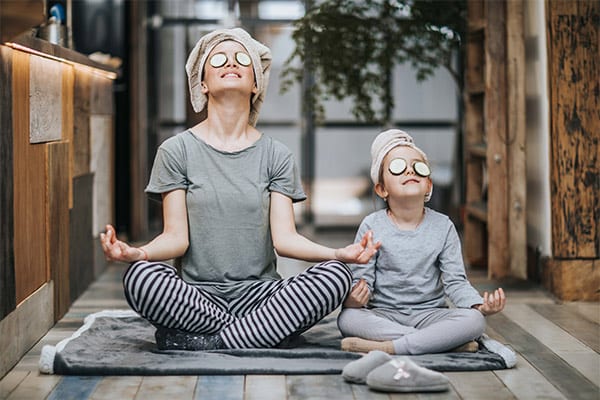
An Eye On Yoga
Changing lifestyles are causing immense strain on our bodies and especially our eyes. Exercise is a good means of rejuvenating the body. But our eyes are often left out. One way to keep our eyes healthy is to go the yoga way. Read on about yoga exercises for the eyes
Our eyes are our windows to the world. However, these days, our 'world' is increasingly limited to our computer or television. Is it any surprise then that stress on the eyes has become a very common problem? Theory is that the natural state of the body is to be at peace. But when we read or watch our favorite programs on television or stare at the computer screen for hours on end it strains the entire body, especially the eyes.
Eye strain and fatigue
A lot of eye problems arise when the eye muscles lose their elasticity. These muscles become very rigid, and this reduces the ability of the lens of the eye to focus at different distances. This in turn causes the eyesight to become weaker. Any tension in the eye will tend to produce a general feeling of tension, since the eye is connected to the brain through the optic nerve. The eye tension produces an increase in the nerve impulses present in the eye muscles. This increase in nerve muscles travels along the optic nerve and bombards the brain causing a general feeling of tension and anxiety. Eye exercises will reduce the tension in the eye muscles as well as the general tension that some of us have.
Eye exercises- the yoga way!
Most of us do not exercise our eye muscles at all, and yet, we work them all the time, putting them under constant strain. The only time the eyes rest for more than a split second, is when we are asleep. Exercising help tone the eye muscles and keep them elastic. For people who already have eye problems, allay your fears as you will notice your eyesight improving after a few months, if you start exercising your eyes. Any form of exercise, including walking, reduces the pressure on the eyeballs and is beneficial for the eyes.
Yoga offers a number of eye exercises. Below are a few yogic eye exercises to strengthen the eyes. They are easy to do, and keeping in mind the hectic schedules of today, most of them can be performed any time of the day, wherever you are:
- One of the best poses for relaxing the eyes, body and mind is known as the 'corpse position'. In this relaxed posture, total calmness, and peace is felt when the whole body and mind have taken complete rest. Here are a few steps to get into position:
– Lie motionless on the floor and close the eyes.
– Close your eyes.
– Relax all body parts from the toes to the head. - Squeeze your eyes shut, so the eye muscles contract. Hold this contraction for three seconds, and then let go quickly. This exercise causes a deep relaxation of the eye muscles, and is especially beneficial after the slight strain caused by the eye exercise.
- Blink your eyes a few times. Do this at least six times. Move your eyes upwards as far as you can, and then downwards as far as you can. Repeat four more times. Blink quickly a few times to relax the eye muscles.
- Shut your eyes and roll your eyeballs around for a minute.
- Imagine there is a huge clock right in front of you. Look at the number 12 for around 10 seconds, and then move your gaze down to 6. Do this 10 times, rapidly. Then, move your eyes horizontally, in the 3-9 position. Finally, move them diagonally (in the 2-7 and 10-4 positions).
- Look up towards the area in the middle of your eyebrows. Hold your gaze for a few seconds and then move your eyes downwards, towards your nose. This is called Sambhavi mudra.

- Slowly, direct your gaze to the ceiling, as you inhale. Exhale, and move your gaze down in a straight line, towards the floor. Do this 6 times.
- Sit in a room by the window, and focus on a point in the distance. Hold your arm straight out in front of you, in the same direction as the point you are focusing on, with your thumb extended in a 'thumbs-up' position. Your thumb should be directly in the line of vision at the object you are focusing on in the distance. Now, keep shifting your focus from your thumb to the point in the distance. Do this around ten times, and at least once a day.
- Rub your palms together and gently cup them over your closed eyes for around a minute. This is known as 'palming' and is very beneficial for the eyes. The eyes need darkness to rejuvenate themselves and this need is best served by palming. Palming should be done after every eye exercise and every now and then during the day to relax the eyes.
- This exercise should not be done until three or four days after you have begun the other eye exercises given here. First slowly roll your eyes clockwise, then counterclockwise as follows: Lower your eyes and look at the floor, then slowly move the eyes to the left, higher and higher until you see the ceiling. Now continue circling to the right, lower and lower down, until you see the floor again. Do this slowly, making a full-vision circle. Now blink, close your eyes and rest. Then repeat the same action counterclockwise. Do this five times then blink the eyes for at least five seconds. When rolling the eyes, make as large a circle as possible, so that you feet a little strain as you do the exercise. This stretches the eye muscles to the maximum extent, giving better results.
Yoga plays a significant role in promoting eye health. A yoga routine complete with asanas and meditation helps in achieving peace and tranquility. Yogic eye exercises strengthen the muscles of the eyes and thus help in keeping the eyes healthy.

Other good practices
If your work entails sitting in front of the computer screen for many hours, then get up every half an hour and move around a bit. Get yourself a glass of water and give your eyes a two minute break.
Blinking lubricates the eyes. However, we tend to blink less when we are concentrating. So make a conscious effort to blink more.
Bright lights increase eye strain. Avoid bright lights in your workplace or home. The same holds for the brightness of your computer and TV screen. Adjust the brightness to a comfortable level.







